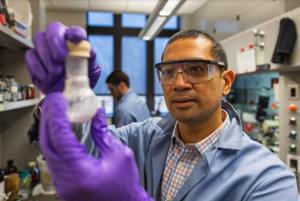
In return, I get a raised eyebrow, or an intrigued look followed by a question: “Like Breaking Bad?” Actually, no. I am a medicinal chemist — a drug hunter, if you will. As a medicinal chemist, I perform chemical reactions to create molecules with the right components to have pharmaceutical effects that benefit society.
My focus is on developing therapeutics for obesity and kidney disease. About one in seven U.S.

adults are affected by kidney disease. That’s about 37 million Americans. The function of kidneys is to filter blood and remove toxins, but when trauma or chronic insults occur, they become injured and malfunction.
Unfortunately, symptoms occur only at the late stage, necessitating dialysis or kidney transplant. The comorbidities are obesity and high blood pressure, both of which are prevalent in the U.S.
It turns out that heart bypass surgery or chemotherapy treatments can also result in kidney injury, exacerbating the problem. In our work, we discovered that a small molecule present in the body called sphingosine-1-phosphate, or S1P, plays a key role in the development of kidney disease. Our goal is to stop its action by blocking its production or its transport by using small molecule drugs.
Tweaking the molecules by adding and removing pieces like a Lego, we can plug the enzyme or transporter to block its signal. We have been successful in demonstrating that our strategy works in both cells and animal models of kidney disease. As mentioned before, obesity is a major comorbidity of kidney disease.
About 40% of U.S. adults or 100 million people are obese.
Obesity is defined as having a body mass index (a measure of body fat based on height and weight) of 30 or above. While diet and exercise are the preferred treatment, staying faithful to this regimen is typically unsuccessful. Fortunately, there are now Food and Drug Administration-approved drugs such as Ozempic and Zepbound that work in part by decreasing food intake.
Obesity occurs because the balance of energy in (food intake) and energy out (nutrient metabolism) is skewed. In our work, we focus on increasing energy expenditure by enhancing metabolism. Organelles in the cell called mitochondria are the power engines that generate ATP — the energy currency in the body.
We have developed molecules called mitochondrial uncouplers that make the mitochondria less efficient, requiring the burning of more nutrients per unit of ATP. In effect, we increase respiration without physical exercise. Mice fed a Western diet high in sugar and fats become obese, and treatment with our compounds leads to fat loss without affecting muscle mass and food intake.
Wouldn’t it be great to put exercise in a pill? That is our ultimate goal. While we have made significant progress in drug development, there is still a long journey ahead. Fundamental research in our laboratories is just the beginning of an extensive process towards creating a pill suitable for human consumption.
The process is made even more challenging by the requirement for a comprehensive series of studies to demonstrate safety and tolerability, first in animals and then in humans, followed by clinical trials to prove efficacy in the target patient population. To put this into perspective, the probability of a cancer drug progressing from phase I trials to approval is only 2.4%.
We face considerable challenges, but our promising start gives us hope for developing innovative treatments that could significantly improve the lives of millions affected by obesity and kidney disease..














